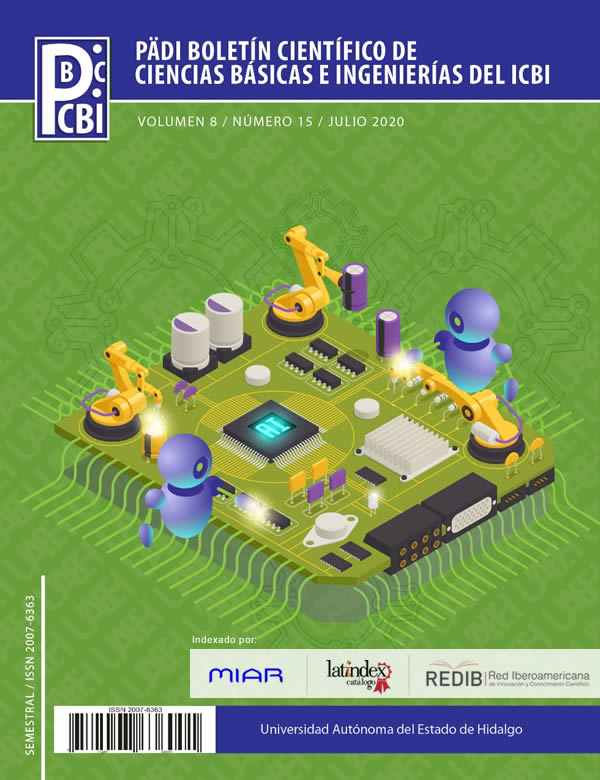Estudios preliminares del transporte de rojo 40 a través de una membrana hibrida
DOI:
https://doi.org/10.29057/icbi.v8i15.5785Palabras clave:
Rojo 40, membrana, hibrida, recuperación, acetato de celulosaResumen
El desarrollo de membranas hibridas ha ganado un especial interés debido a su bajo consumo de energía y adaptabilidad a diferentes medios. La adición de diferentes tipos de compuestos semejantes al oxido de zinc le proporciona adicionalmente una gran selectividad, estabilidad y resistencia al ensuciamiento lo cual permite mejorar los procesos de separación. Es por eso que el propósito del presente trabajo es evaluar cómo influyen algunos parámetros tales como el pH en la fase de alimentación y la naturaleza de la fase de descarga en el proceso de transporte del colorante rojo 40 mediante la utilización de una membrana hibrida de acetato de celulosa con partículas de óxido de zinc. Esto debido a que el rojo 40 es un colorante azoico y cromogénico ampliamente utilizado en la industria textil. Considerando todo lo anterior, la membrana hibrida se probó en una solución sintéticas en donde mostró su utilidad para la recuperación del colorante.
Descargas
Información de Publicación
Perfiles de revisores N/D
Declaraciones del autor
Indexado en
- Sociedad académica
- N/D
Citas
Ang, W. L., Mohammad, A. W., Hilal, N., Leo, C. P., 2015. A review on the applicability of integrated/hybrid membrane processes in water treatment and desalination plants. Desalination 363, 2–18. DOI:10.1016/j.desal.2014.03.008
Bazregar, M., Rajabi, M., Yamini, Y., Asghari, A., Abdossalami asl, Y., 2015. In-tube electro-membrane extraction with a sub-microliter organic solvent consumption as an efficient technique for synthetic food dyes determination in foodstuff samples. Journal of Chromatography A 1410, 35–43. DOI:10.1016/j.chroma.2015.07.084
Candela, A.M., Benatti, V., Palet, C., 2013. Pre-concentration of Uranium (VI) using bulk liquid and supported liquid membrane systems optimized containing bis(2-ethylhexyl) phosphoric acid as carrier in low concentrations. Separation and Purification Technology 120, 172–179. DOI: 10.1016/j.seppur.2013.09.047
Cho, S.H., Shim, J., Moon, S.H., 2009. Detoxification of simulated textile wastewater using a membraneless electrochemical reactor with immobilized peroxidase. Journal of Hazardous Materials 162(2-3), 1014-8. DOI: 10.1016/j.jhazmat.2008.05.133
Dotto, G. L., Vieira, M. L. G., Esquerdo, V. M., Pinto, L. A. A., 2013. Equilibrium and thermodynamics of azo dyes biosorption onto Spirulina platensis. Brazilian Journal of Chemical Engineering, 30(1), 13–21. doi:10.1590/s0104-66322013000100003
Fiol, N., Villaescusa, I., 2009. Determination of Sorbent Point Zero Charge: Usefulness in Sorption Studies. Environmental chemistry letters 7, 79-84. DOI:10.1007/s10311-008-0139-0
Hairom, N. M., Amir, A., Kadhum, H., 2014. Nanofiltration of hazardous Congo red dye: Performance and flux decline analysis. Journal of Water Process Engineering 4, 99-106. DOI:10.1016/j.jwpe.2014.09.008
Ibanez J.G., Hernandez-Esparza, M., Doria-Serrano C., Fregoso-Infante A., Singh M.M., 2008. The Point of Zero Charge of Oxides. In: Environmental Chemistry. Springer, New York, NY. DOI: 10.1007/978-0-387-49493-7_5
Ioelovich, M., 2017. Characterization of Various Kinds of Nanocellulose In Editors: Kargarzadeh, H., Ahmad, I., Thomas, S., Dufresne, A., Handbook of Nanocellulose and Cellulose Nanocomposites Vol I. John Wiley and Sons, Germany, Ch: 2, pp.51-100. DOI: 10.1002/9783527689972.ch2
Jiang, L., Shung, T., Rajagopalan, R., 2007. Matrimid/ MgO mixed matrix membranes for pervaporation. AIChE Journal 53, 1745-1757. DOI: 10.1002/aic.11198
Kataria, N., Garg, V., 2017. Removal of Congo red and Brilliant green dyes from aqueous solutions using flower shaped ZnO nanoparticles. Journal of Environmental Chemical Engineering 5, 5420-5428. DOI:10.1016/j.jece.2017.10.035
Khatri, A. P., 2015. A review on developments in dyeing cotton fabrics with dyes for reducing effluent pollution. Journal of Cleaner Production 87, 50-57. DOI: 10.1016/j.jclepro.2014.09.017
Khoshhesab, Z.M., Souhani, S., 2018. Adsorptive removal of reactive dyes from aqueous solutions using zinc oxide nanoparticles. Journal of the Chinese Chemical Society 65, 1482–1490. DOI:10.1002/jccs.201700477
Li, J., Zhang, G., Wang, N., An, W., 2012. Layer by-layer assembled nanohybrid multilayer membranes for pervaporation dehydration of acetone–water mixtures. Journal of Membrane Sciences 415-416, 745-757. DOI:10.1016/j.memsci.2012.05.066
Mohammadian, M., Es’haghi, Z. H., 2018. Green and chemical synthesis of zinc oxide nanoparticles and size evaluation by UV–vis spectroscopy. Journal of Nanomedicine Research 7, 52-58
Qu, X., Alvarez, P., Li, Q., 2013. Applications of nanotechnology in water and wastewater treatment. Water Research 47, 3931-3946. DOI:10.1016/j.watres.2012.09.058
Ratna, P. B., 2012. Pollution due to synthetic dyes toxicity & carcinogenicity studies and remediation. International Journal of Enviromental Sciences, 940-955. DOI: 10.6088/ijes.2012030133002
Salem, I. A., Salem, M.A., El-Ghobashy, M. A., 2017. The dual role of ZnO nanoparticles for efficient capture of heavy metals and Acid blue 92 from water. Journal of Molecular Liquids 248, 527-538. DOI: 10.1016/j.molliq.2017.10.060
Smolders, C.A., Reuvers, A.J., Boom, R.M., Wienk, I.M., 1992, Microstructures in phase-inversion membranes. Part 1. Formation of macrovoids. Journal of Membrane Science, 73, 259-275. DOI: 10.1016/0376-7388(92)80134-6
Tony, B. D., 2009. Decolorization of textile azo dyes by aerobic bacterial consortium. International Biodeterioration & Biodegradation, 63(4), 462-469. DOI: 10.1016/j.ibiod.2009.01.003
Torres-Perez, J., Huang, Y., Bazargan, A., Khoshand, A., McKay, G., 2020. Two‑stage optimization of Allura direct red dye removal by treated peanut hull waste. SN Applied Sciences, 2, 475. DOI: 10.1007/s42452-020-2196-3
Wang, Y., Yang, L., Luo, G., Dai, Y., 2009. Preparation of cellulose acetate membrane filled with metal oxide particles for the pervaporation separation of methanol/methyl tert-butyl ether mixtures. Chemical Engineering Journal 146, 6-10. DOI: 10.1016/j.cej.2008.05.009
Yang, D., Li, J., Jiang, Z., Lu, L., Chen, X., 2009, Chitosan/TiO2 nanocomposite pervaporation membranes for ethanol dehydration. Chemical Engineering Sciences 64, 3130-3137. DOI: 10.1016/j.ces.2009.03.042
Yang, Y., Wang, P., 2006. Preparation and characterizations of a new PS/TiO2 hybrid membranes by sol–gel process. Polymer 47(8), 2683-2688. DOI: 10.1016/j.polymer.2006.01.019




















